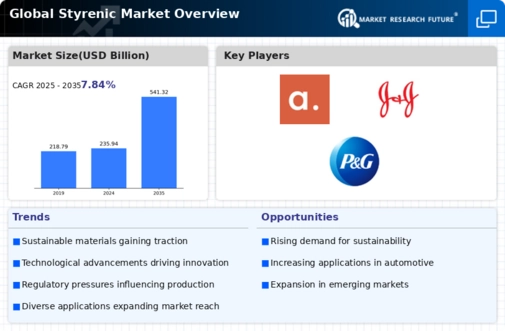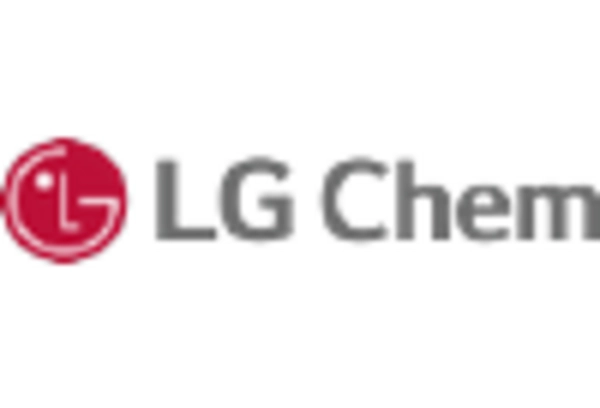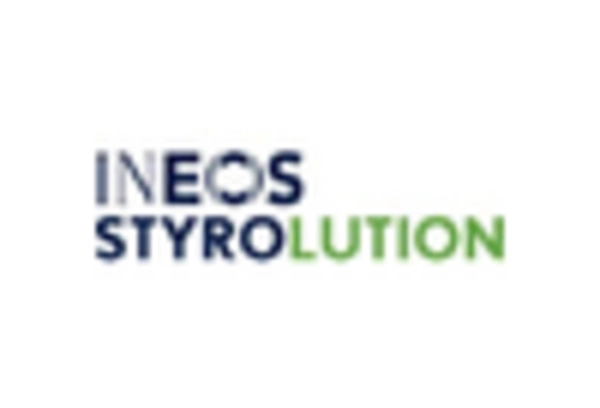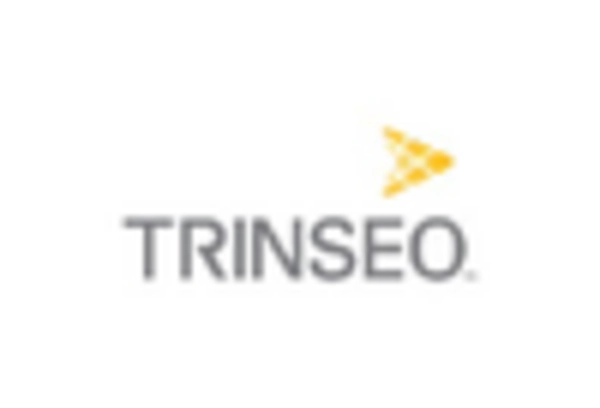-
Executive Summary
-
Market Introduction
-
Market Definition
-
Scope of the Study
-
Assumptions & Limitations
-
Market Structure
-
Key Takeaways
-
Market Insights
-
Research Methodology
-
Research Process
-
Primary Research
-
Secondary Research
-
Market Size Estimation
-
Forecast Model
-
Market Dynamics
-
Introduction
-
Drivers
-
Restraints
-
Opportunities
-
Challenges
-
Trends
-
Market Factor Analysis
-
Supply Chain Analysis
- Raw Material Suppliers
- Manufacturers/Producers
- Distributors/Retailers/Wholesalers/E-Commerce Merchants
- End-Users
-
Porter’s Five Forces Analysis
- Threat of New Entrants
- Intensity of Competitive Rivalry
- Threat of Substitutes
- Bargaining Power of Suppliers
- Bargaining Power of Buyers
-
Pricing Analysis
-
Global Styrenic Polymers Market, by Type
-
Introduction
-
General Purpose Polystyrene
- Market Estimates & Forecast, 2020-2027
- Market Estimates & Forecast, by Region, 2020-2027
-
High Impact Polystyrene
- Market Estimates & Forecast, 2020-2027
- Market Estimates & Forecast, by Region, 2020-2027
-
Acrylonitrile Butadiene Styrene
- Market Estimates & Forecast, 2020-2027
- Market Estimates & Forecast, by Region, 2020-2027
-
Styrene Acrylonitrile
- Market Estimates & Forecast, 2020-2027
- Market Estimates & Forecast, by Region, 2020-2027
-
Others
- Market Estimates & Forecast, 2020-2027
- Market Estimates & Forecast, by Region, 2020-2027
-
Global Styrenic Polymers Market, by End-Use Industry
-
Introduction
-
Automotive and transportation
- Market Estimates & Forecast, 2020-2027
- Market Estimates & Forecast, by Region, 2020-2027
-
Building and construction
- Market Estimates & Forecast, 2020-2027
- Market Estimates & Forecast, by Region, 2020-2027
-
Packaging
- Market Estimates & Forecast, 2020-2027
- Market Estimates & Forecast, by Region, 2020-2027
-
Consumer Goods
- Market Estimates & Forecast, 2020-2027
- Market Estimates & Forecast, by Region, 2020-2027
-
Medical
- Market Estimates & Forecast, 2020-2027
- Market Estimates & Forecast, by Region, 2020-2027
-
Sports & Leisure
- Market Estimates & Forecast, 2020-2027
- Market Estimates & Forecast, by Region, 2020-2027
-
Personal Care
- Market Estimates & Forecast, 2020-2027
- Market Estimates & Forecast, by Region, 2020-2027
-
Others
- Market Estimates & Forecast, 2020-2027
- Market Estimates & Forecast, by Region, 2020-2027
-
Global Styrenic Polymers Market, by Region
-
Introduction
-
North America
- Market Estimates & Forecast, 2020-2027
- Market Estimates & Forecast, by Type, 2020-2027
- Market Estimates & Forecast, by End-Use Industry, 2020-2027
- US
- Canada
-
Europe
- Market Estimates & Forecast, 2020-2027
- Market Estimates & Forecast, by Type, 2020-2027
- Market Estimates & Forecast, by End-Use Industry, 2020-2027
- Germany
- France
- Italy
- Spain
- UK
- Russia
- Poland
-
Asia-Pacific
- Market Estimates & Forecast, 2020-2027
- Market Estimates & Forecast, by Type, 2020-2027
- Market Estimates & Forecast, by End-Use Industry, 2020-2027
- China
- India
- Japan
- Australia & New Zealand
- Indonesia
- Rest of Asia-Pacific
-
Middle East & Africa
- Market Estimates & Forecast, 2020-2027
- Market Estimates & Forecast, by Type, 2020-2027
- Market Estimates & Forecast, by End-Use Industry, 2020-2027
- Turkey
- Israel
- South Africa
- GCC
- Rest of the Middle East & Africa
-
Latin America
- Market Estimates & Forecast, 2020-2027
- Market Estimates & Forecast, by Type, 2020-2027
- Market Estimates & Forecast, by End-Use Industry, 2020-2027
- Brazil
- Argentina
- Mexico
- Rest of Latin America
-
Competitive Landscape
-
Introduction
-
Market Strategy Analysis
-
Key Development Analysis
-
(Expansions/Mergers & Acquisitions/Joint Ventures/New Product Developments/Agreements/Investments)
-
Company Profiles
-
Asahi Kasei Corporation
- Company Overview
- Financial Overview
- Product/Business Segment Overview
- Key Developments
- SWOT Analysis
- Key Strategies
-
JSR Corporation
- Company Overview
- Financial Overview
- Product/Business Segment Overview
- Key Developments
- SWOT Analysis
- Key Strategies
-
ARLANXEO
- Company Overview
- Financial Overview
- Product/Business Segment Overview
- Key Developments
- SWOT Analysis
- Key Strategies
-
Lion Elastomers
- Company Overview
- Financial Overview
- Product/Business Segment Overview
- Key Developments
- SWOT Analysis
- Key Strategies
-
Versalis SpA
- Company Overview
- Financial Overview
- Product/Business Segment Overview
- Key Developments
- SWOT Analysis
- Key Strategies
-
Reliance Industries Limited
- Company Overview
- Financial Overview
- Product/Business Segment Overview
- Key Developments
- SWOT Analysis
- Key Strategies
-
Zeon Corporation
- Company Overview
- Financial Overview
- Product/Business Segment Overview
- Key Developments
- SWOT Analysis
- Key Strategies
-
LG Chem
- Company Overview
- Financial Overview
- Product/Business Segment Overview
- Key Developments
- SWOT Analysis
- Key Strategies
-
Trinseo
- Company Overview
- Financial Overview
- Product/Business Segment Overview
- Key Developments
- SWOT Analysis
- Key Strategies
-
KUMHO PETROCHEMICAL
- Company Overview
- Financial Overview
- Product/Business Segment Overview
- Key Developments
- SWOT Analysis
- Key Strategies
-
Goodyear Rubber Company
- Company Overview
- Financial Overview
- Product/Business Segment Overview
- Key Developments
- SWOT Analysis
- Key Strategies
-
Appendix
-
-
LIST OF TABLES
-
Global Styrenic Polymers Market, by Region, 2020-2027
-
North America: Styrenic Polymers Market, by Country, 2020-2027
-
Europe: Styrenic Polymers Market, by Country, 2020-2027
-
Asia-Pacific: Styrenic Polymers Market, by Country, 2020-2027
-
Middle East & Africa: Styrenic Polymers Market, by Country, 2020-2027
-
Latin America: Styrenic Polymers Market, by Country, 2020-2027
-
Global Styrenic Polymers Market, for Type, by Region, 2020-2027
-
North America: Styrenic Polymers Market, for Type, by Country, 2020-2027
-
Europe: Styrenic Polymers Market, for Type, by Country, 2020-2027
-
Asia-Pacific: Styrenic Polymers Market, for Type, by Country, 2020-2027
-
Middle East & Africa: Styrenic Polymers Market, for Type, by Country, 2020-2027
-
Latin America: Styrenic Polymers Market, for Type, by Country, 2020-2027
-
Global Styrenic Polymers Market, for End-Use Industry, by Region, 2020-2027
-
North America: Styrenic Polymers Market, for End-Use Industry, by Country, 2020-2027
-
Europe: Styrenic Polymers Market, for End-Use Industry, by Country, 2020-2027
-
Asia-Pacific: Styrenic Polymers Market, for End-Use Industry, by Country, 2020-2027
-
Middle East & Africa: Styrenic Polymers Market, for End-Use Industry, by Country, 2020-2027
-
Latin America: Styrenic Polymers Market, for End-Use Industry, by Country, 2020-2027
-
Global Type Market, by Region, 2020-2027
-
Global End-Use Industry Market, by Region, 2020-2027
-
North America: Styrenic Polymers Market, by Country, 2020-2027
-
North America: Styrenic Polymers Market, by Type, 2020-2027
-
North America: Styrenic Polymers Market, by End-Use Industry, 2020-2027
-
Europe: Styrenic Polymers Market, by Country, 2020-2027
-
Europe: Styrenic Polymers Market, by Type, 2020-2027
-
Europe: Styrenic Polymers Market, by End-Use Industry, 2020-2027
-
Asia-Pacific: Styrenic Polymers Market, by Country, 2020-2027
-
Asia-Pacific: Styrenic Polymers Market, by Type, 2020-2027
-
Asia-Pacific: Styrenic Polymers Market, by End-Use Industry, 2020-2027
-
Middle East & Africa: Styrenic Polymers Market, by Country, 2020-2027
-
Middle East & Africa: Styrenic Polymers Market, by Type, 2020-2027
-
Middle East & Africa: Styrenic Polymers Market, by End-Use Industry, 2020-2027
-
Latin America: Styrenic Polymers Market, by Country, 2020-2027
-
Latin America: Styrenic Polymers Market, by Type, 2020-2027
-
Latin America: Styrenic Polymers Market, by End-Use Industry, 2020-2027
-
-
LIST OF FIGURES
-
Global Styrenic Polymers Market Segmentation
-
Forecast Methodology
-
Porter’s Five Forces Analysis of Global Styrenic Polymers Market
-
Supply Chain Analysis of Global Styrenic Polymers Market
-
Share of Styrenic Polymers Market, by Country, 2020 (%)
-
Global Styrenic Polymers Market, 2020-2027
-
Sub-Segments of Type
-
Global Styrenic Polymers Market Size, by Type, 2020 (%)
-
Share of Global Styrenic Polymers Market, by Type, 2020-2027
-
Sub-Segments of End-Use Industry
-
Global Styrenic Polymers Market Size, by End-Use Industry, 2020 (%)
-
Share of Global Styrenic Polymers Market, by End-Use Industry, 2020-2027

















Leave a Comment